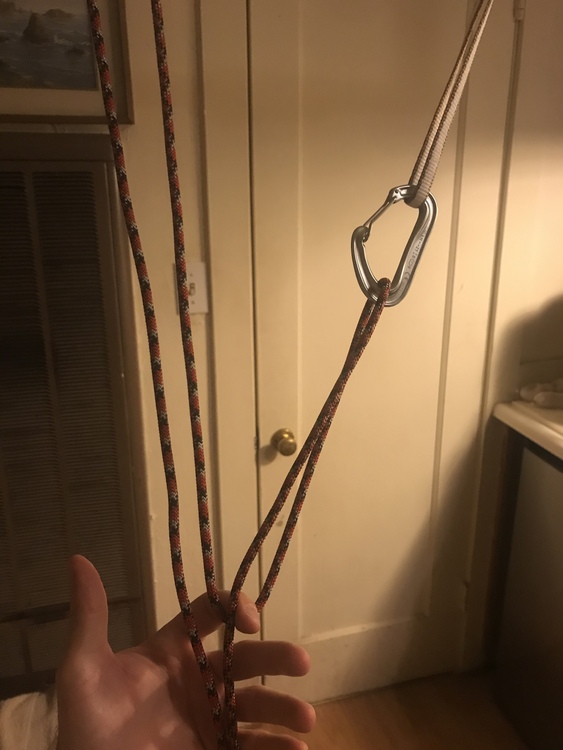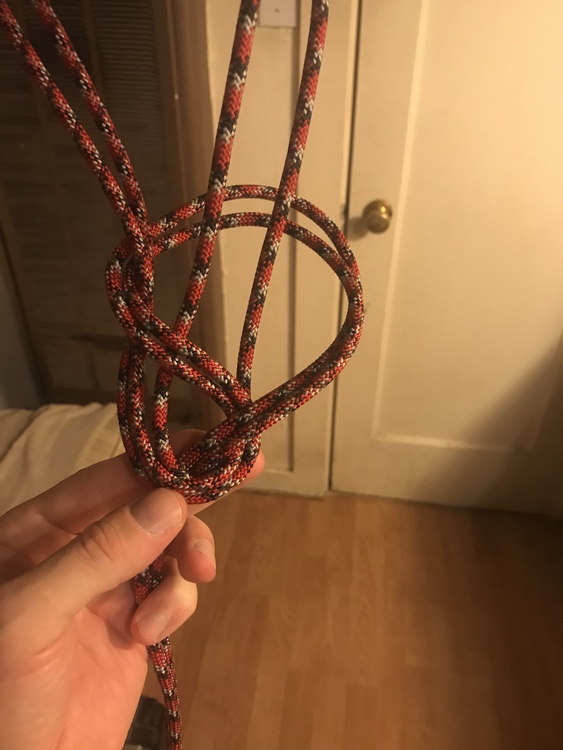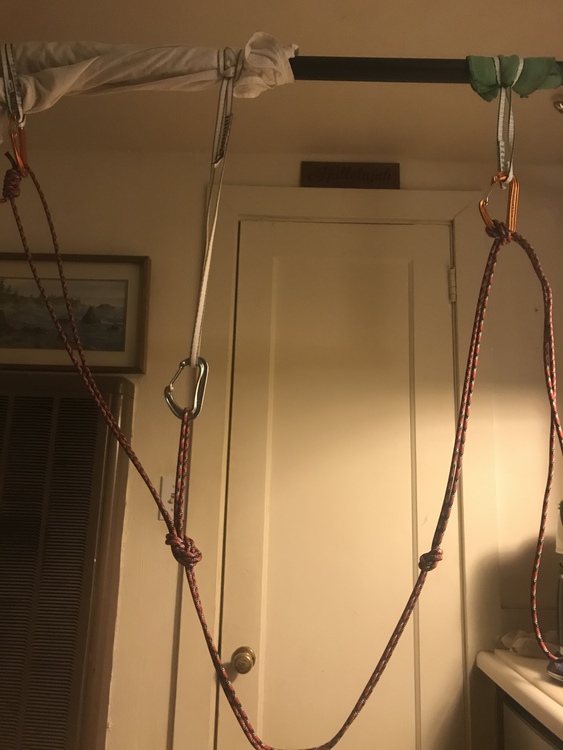A threefold cord is not quickly broken
|
|
Is there a name for this method of equalizing, is there any reason not to use it? Seems like a fast and efficient way to start a anchor using less material. Please let me know what the method or knot is called and any reason not to use it in conjunction with a clove hitch at a third point. Or Improve Thanks and GOD Bless, Colin McCurdy |
|
|
I'll be the first to say, YGD. |
|
|
Kinda looks like a three piece quad. YGD. Carry on. |
|
|
It’s called a triple-fisherman-short-bight-really-long-bight-figure-eight-overhand-clove-hitch. Most people don’t use it cause the name is way to long. |
|
|
I was thinking a sliding x between the limiter knots and that it was a lot faster and easier to equalize then a super 8. However because I haven’t heard of it before... I was thinking there might be a reason. Please let me know if there is |
|
|
I always try to incorporate redundant t-shirts into my anchor system. That wash rag looks sketch |
|
|
Don’t get too personal now... taking shots at my undershirt... Have a Great night and GOD Bless, Colin McCurdy |
|
|
One way to use less material… untie the cordelette, clove hitch one end to the left piece, clove hitch the other end to the right piece, loop the cord through the middle piece, pull down the two sections and tie a master point like normal with an overhand or figure-8. You can also use figure-8s on a bight instead of the cloves on each end of the cordelette. One negative with this method is you lose the shelf. I haven’t seen an anchor built using the method in your photos. It’s creative! My suggestion would be to tie a master point instead of sliding x for easier clipping into the anchor. |
|
|
This anchor is an equalette and is the predecessor for the quad. When I started climbing this was the new cool kid on the block and published in the book Climbing Anchors by John Long. I believe that later testing showed that it doesn’t have the equalization properties they were hoping for and it has generally been scrapped by most folks it seems for simpler masterpoint style anchors or quads. I don’t personally care for these sliding systems as I don’t think they provide any advantage for all but fringe cases. Given the material pictured- I would likely have just tied an overhand for the left piece- tied big enough that you could clip the second piece just below the knot. Then the third piece just clipped, then tie a nice fat overhand or figure 8 or figure 9 depending on how high you want it to be. Alternatively I’d just combine the 2 left pieces with the cord or a sling as a simple ponytail masterpoint anchor, clove in, then clove the backside of my lead rope to the third piece as a backup. But your method looks super good enough and I wouldn’t look at it twice if we were climbing together as long as it didn’t take you more than a minute to construct. |
|
|
Yes similar to an equalette. You could put a twist in one of the PowerPoint stands to make it a sliding x to give it redundancy, But if you don’t make the strand with the twist longer to accommodate the twist it will bind and reduce much of the load sharing (it’s never really equalization). “Equalization” again really load sharing, is usually overrated. Each piece should be strong enough on its own to be the anchor. And you have multiple pieces for redundancy. Simplicity and ease of inspection is probably more important. Where the sliding anchors are good is if the load (climber) is moving from side to side. So for example a quad is a great top rope anchor if you’re going to climb multiple climbs off the same anchor or the line traverses. Hail THOR! |
|
|
Shucks I was thinking I was going to get to name it... Came up with a name and everything Looked up equalette... that looks to be something different, the primary focus here is the knot and or equalization method in the knot... not so much the other stuff... you can put a master point in... looks like the equalette uses clove hitches which personally i am fine with, but from my vantage this still seems better... until you convince me otherwise... personally I’ll probably primarily be using a 180 or 240 sling and tor guy your right if I was going to be using a sliding x I’d put it in prior to tying the third point with whatever knot seems clever at that moment... to be Honest this isn’t that novel of a idea it probably does have a name and use in some distant country... but until I learn of it In my Mind I’m Smiling thinking about building fast, efficient climbing anchors... naming them... So if I still get to name this puppy... drum roll Please I’ll name it... A threefold cord A threefold cord is not quickly broken Ecclesiastes 4:12 |
|
|
With a super 8 if anything is severed in either of the legs... both anchors go... is there more of a possibility of one of the anchors remaining intact with this knot if the other leg above the knot is compromised... Could clipping a strand of each of the legs above the knot qualify as a shelf? Although single strand clove hitching is fast, efficient and requires less material do you think that the added benefit of having a double strand throughout is worth taking into consideration. King James says Two are better than one Really check it out and read it for yourself
Ecclesiastes 4:9 |
|
|
Colin McCurdy wrote: Pictured is an equalette anchor using a a double figure-8. The specific knots or hitches used don't always create a "new" anchor. A quad is a quad whether you use an 8 or an overhand etc. An equallete can use clove hitches, or figure 8s, but the main point is that it's a modified limiting knot anchor that incorporates 3 or more points. Combining 2 legs of an anchor with a double figure-8 is a method used all the time - though IMO other methods are often faster and have more material efficiency. If you tied an overhand on a bite for your master point, this would be just a variation of the more traditional pony-tail anchor. IMO, no reason to add a new name to the mix for an anchor variation that has a very small range of applications and is functionally exactly the same as other methods. |
|
|
Applications and merits of different systems... state your case I’m hearing people saying that the above mentioned system has limited application but I’m not seeing that... it would and should be built for a direct load and in that sphere would distribute the load just as well as other systems... in my mind... Correct me if I’m wrong where it would excel is in a indirect load where in Reality the initial load would be on a single piece in most systems... In a system like the one above (for now I’m still going to call it a threefold cord... call it what you want) The load would always be distributed between two points at a minimum... Correct as previously mentioned Two are better than one John 1:1 |
|
|
How to make an anchor: Place 2-3 good pieces and tie them together with a master point any way you like. Unless you are rope jumping you're all good. |
|
|
Is there A Better Way though one may be overpowered, two can resist. Moreover, a cord of three strands is not quickly broken. John 14:6 |
|
|
Yes and this could have its place being both utilitarian and dynamic This could present issues if you Have to Lead Romans 1:16 the next pitch or have used the majority of rope on the previous pitch Ephesians 2:8-10 |
|
|
If you are really attempting to distribute the load as equally as possible among the three anchors, then this is not the way to go, since if tied perfectly (which doesn't appear to be the case in the picture) it would put roughly half the load to the right-hand anchor, 3/8 of the load on the middle anchor, and only 1/8 of the load on the left-hand anchor. With that theoretical distribution, you certainly don't want to speak about "equalization," which is hard enough to achieve even if the rigging isn't working against you. As pictured, the left strand might be too long and so the rigging will just load the middle and right anchors, with the left anchor out of the picture unless both the middle and right anchor fail. You won't get any extension if the left or middle anchor fails, but there is going to be a substantial extension if the right anchor fails. The extension-limiting knot on the right strand should be closer to the bottom to lessen that extension. The clove hitch is fine, but if the tail comes out a lot shorter, it is typical to clip the loop back to the carabiner as a backup in case of slippage. Unless you have some reason to concentrate the load on the right-hand piece, the traditional three-fixed-arm configuration seems better to me, which looks as if it would distribute 1/4 of the load to each left and right anchor and 1/2 the load to the center anchor, of course with no extension penalty in case of anchor point failure. |
|
|
Philippians 2:4 there have been test done that indicate that the friction in sliding systems such as are being discussed will actually load one piece more then another... these test are probably scientific and far more credible then my observations... in my mind a unevenly distributed load across 2 anchors is still far better then one piece taking the full load as it appears... but things aren’t always as they appear Proverbs 3:5-6 As mentioned shock loading should be taken into consideration should a leg go... personally I’m going to defer to the more knowledgeable and be Grateful for the opportunity to Learn I Greatly Appreciate the insight! Master point with the last piece of pro in the pitch being a directional piece without extension to maintains the direction of load Good Experience, Thanks! have a Great day and GOD Bless, Colin McCurdy Romans 15:1-6 |
|
|
I started skimming when I saw the Bible verses.. what is the problem you are trying to solve here? |
|
|
Let's try closing the bible for a minute and trolling for axioms elsewhere. It is well known that when you do anything, unless you understand its actual circumstances, its nature and its relations to other things, you will not know the laws governing it, or know how to do it, or be able to do it well. --Mao Tse Tung |

 Continue with onX Maps
Continue with onX Maps Sign in with Facebook
Sign in with Facebook



























